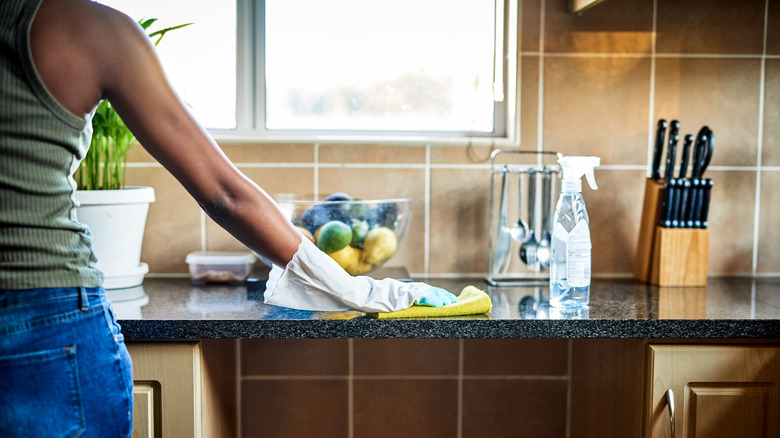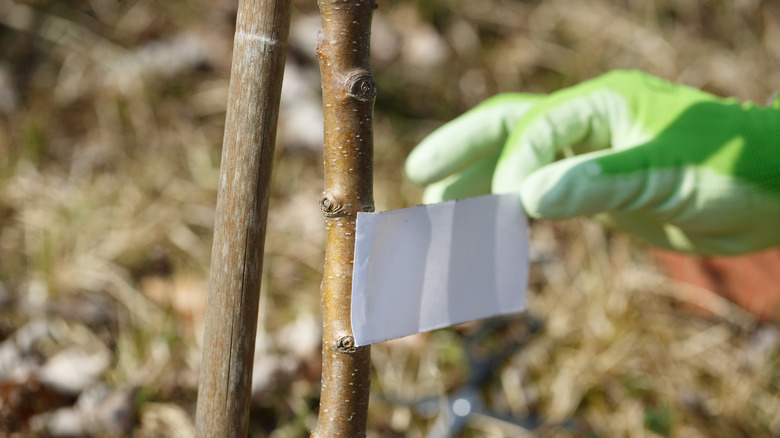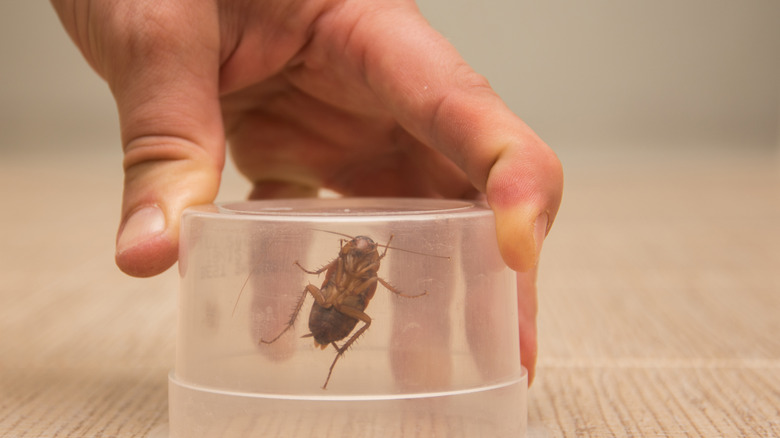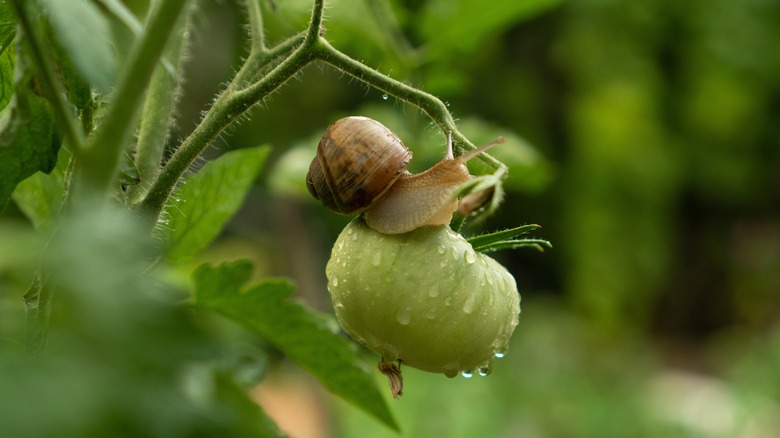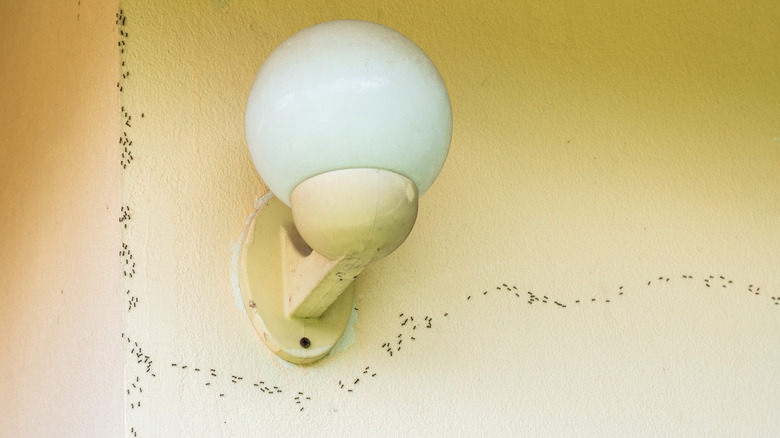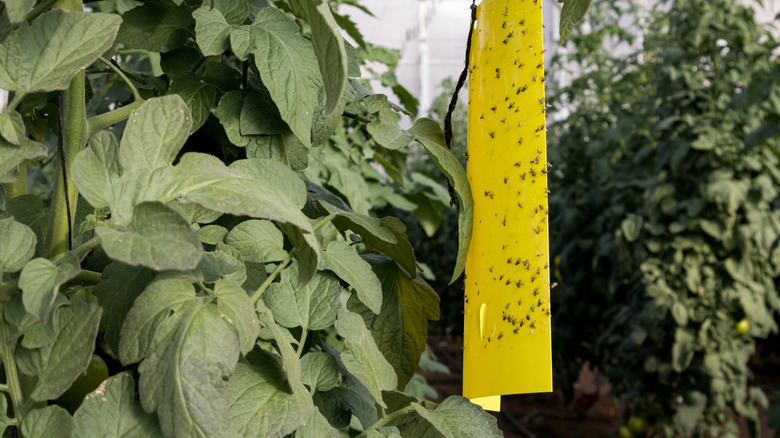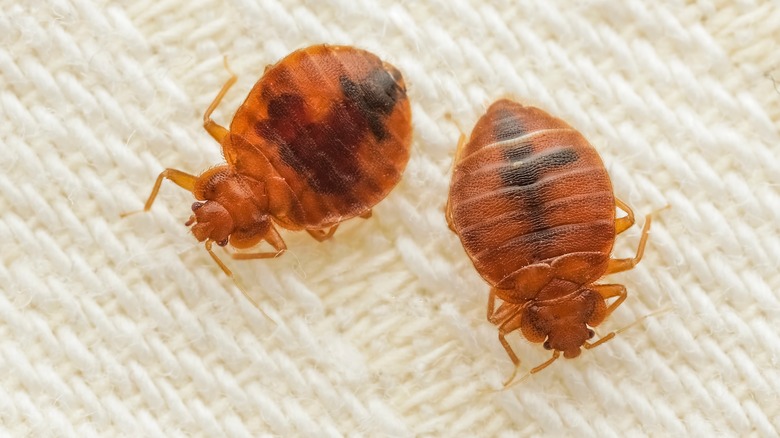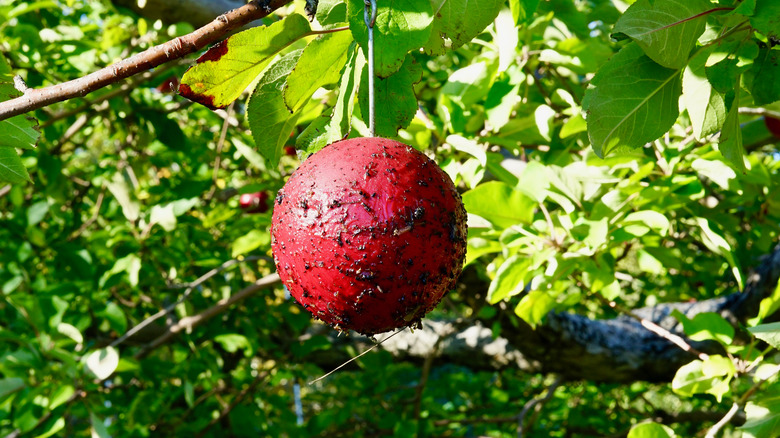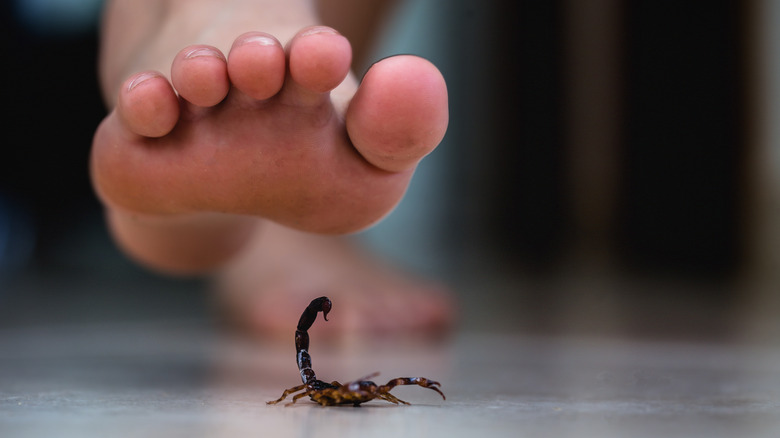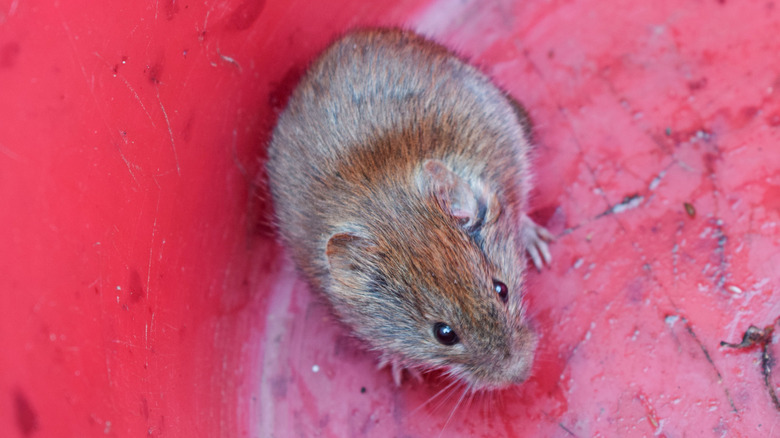Where And How To Use Vaseline To Keep Pests Out Of Your House
Petroleum jelly has a lot of uses around the house, whether that's removing scratches, descuffing leather, or lubricating hinges. But another area where Vaseline shines is in helping you combat pests in the home and garden, especially insects.
This mostly has to do with the texture of petroleum jelly, and not with any kind of toxicity. This is important because it will allow you to think creatively about your pest control; you can theorize what traps to set that will either trap the bugs in the goo or have them slip from where they're trying to climb.
If you've used toxic chemicals in an attempt to get rid of ants or, heaven forfend, scorpions, you already know that even the harshest poisons aren't 100% effective, and it's easy to overlook simpler physical means of keeping pests away or trapping them, like Vaseline. Every little bit helps, and having one fewer scorpion in your house is far better than having one more scorpion. Let's take a look at the best ways to do this.
Use on stems/trunks
Putting petrolatum on the stems and trunks of plants is said to deter creepy crawlies like aphids, scale, ants, earwigs, and more. There are a few variations of this approach, and a few critically important caveats to keep in mind.
Mostly, such tricks involve protecting garden plants, from vegetable garden annuals to woody perennial shrubs. The idea is that insects and other pests, such as aphids and earwigs, will get stuck if they try to climb onto your previous peonies. There are some important things to keep in mind. Insects like aphids often have more than one way of ending up on your plants. You might stop the ones climbing the stem, but Vaseline won't have any effect on those that fly in. And when it comes to bugs like spiders and earwigs, ask yourself if what you're doing makes sense. Earwigs can cause plant damage, but usually don't, and spiders are about 100% beneficial in a garden.
You must keep Vaseline off of leaves. It will certainly destroy the leaf, leaving it unable to respirate, and coating too many leaves will kill the entire plant. Also, keep an eye on the frequency of reapplication. Do you really want to put petroleum jelly all over your garden every three or four days, as Plantsbank recommends? And note that some users have reported damage to, or weakening of, plants' stems after applying petrolatum. One approach with trees is to apply a barrier band around the trunk, to which a sticky layer of Vaseline can be applied.
Jar traps for roaches
There is someone who will describe just about any insect as a pest, no matter how beneficial and harmless it is. But almost everyone agrees that cockroaches aren't to be tolerated. These insects are actually very interesting in a number of ways, and more exotic species are even kept as pets, but the average homeowner would be happy to eradicate them from the face of the earth.
The jar trap has a couple of similar variations. In general, you use either a jar or a jar lid, depending on trap location and the severity of your "infestation." (As far as we're concerned, one cockroach amounts to an infestation.) You'll put some kind of sweet fruit in the center of the jar or lid, and coat the rim/edge with Vaseline. The bugs will get trapped either trying to get to the food or trying to leave after they've had their fill. It might be wise to use jars rescued from the recycling bin, which you can throw away without a lot of guilt, because it's pretty unlikely that you'll clean out your roach trap to use it again.
Repel snails and slugs
Snails and slugs are serious trouble to the gardener. And, perhaps more to the point, some people seem to have an instinctive distaste for the slimy critters that might be described as a clinical phobia. So, as you might imagine, there are lots of homemade remedies around to help you get rid of the pests, and a couple of versions involve petroleum jelly.
The basic idea is that, to protect potted plants, you can apply petrolatum to the top edge of a plant pot, which snails and slugs will have difficulty slogging through. It seems to be effective, but there's a variation that has a couple of advantages, in that it actually kills the snails and slugs, and it can cure you if you happen to have an over-fondness for margaritas. It starts the same: slather a coat of Vaseline around the base and rim of the plant pot. Then, add salt. In this version, the Vaseline holds the salt in place. It seems that snails and slugs are even slower to put on their brakes than they are to accelerate, so by the time they recognize they've inched into the world's most disgusting salt rim, they are already doomed to pass from this mortal slime. All that said, it is important to remember that salt can be hard on the plants you're trying to protect, so be mindful of your application.
Deter ants
Ant infestations are a kind of slow-motion torture, an incremental escalation from harmlessness to utter mayhem that rivals the levels of madness brought on by arsenic poisoning or reality television. Fortunately, perhaps the most common pest control use for petroleum jelly is to rid a house of ants. And if you've ever seen just how persistent ants can be, you know this is impressive.
The mechanism that makes this effective appears to simply be that ants can't traverse anything coated with petroleum jelly. (Perhaps their alarmist homeopaths have warned them against aspirating the stuff.) The methodology here is to apply a barrier at any point of ant entry, substantial enough to dissuade these stubborn bugs. Some mention that it can be used to effectively fill gaps, like a kind of silicone sealant that never dries. However, as Forbes points out, this solution won't last forever. (Why you wouldn't use actual silicone caulk, thereby bypassing the need for constant reapplication, is a mystery for the ages. Perhaps it's more appealing to kill the ants that try to transgress the demilitarized zone?) Incidentally, if you find this treatment of ants unconscionable, do yourself a favor and don't read about how diatomaceous earth, another nontoxic ant remedy, actually works.
Ideally, you'll create your Vaseline ant barriers in some area protected from the weather. Especially in hot weather, when you're most likely to have ant issues, petroleum jelly can run or wash away. Ants will notice, so you must also notice and reapply the stuff.
Sticky trap for whiteflies
Whiteflies can do a lot of damage to a garden. Here's a trick that actually works to deter them, and which also helps with flea beetles and aphids. Whiteflies are closely related to aphids and scale, and they damage plants in a similar way: sucking out the juices from healthy plant matter while in their larval and adult stages. Whiteflies are also closely related to college students, apparently, because they leave excess food about to get moldy. In the case of whiteflies, this mold results from an excretion called honeydew, which is fed on by a black mold. But unlike the moldy takeout containers you might find in a dorm room, moldy honeydew can restrict photosynthesis and make your plants unhealthy.
This trick for exterminating whiteflies won't do much against the larvae population, but it should hamper the flying adult stage of the insect. The idea is to hang yellow plastic cups or cards around your garden, coated with petroleum jelly. The whiteflies and similar insects are apparently attracted to the color, and will get themselves stuck in the Vaseline.
On bed frames to deter bed bugs
There are a handful of ways to get rid of bed bugs. The easiest option may very well be selling your house well below market value. Now, if you're ready for a little more work, there are of course ways to deal with the pests without relocating entirely. One method involves laundering and sanitizing everything in sight, perhaps with the occasional soaking of pyrethrins that are perfectly harmless unless you breathe them, in which case you might die. Who wouldn't look for a gentler alternative, backed by common sense and superhuman feats of optimism. Vaseline won't get rid of bed bugs, but perhaps you can slow them down with this one simple trick.
If you smear petroleum jelly on bed frames, chair legs, and doorframes, the bed bugs will have a hard time climbing up the furniture. It's certainly possible that this would do some good in reducing the mobility (and presumably numbers) of bed bugs. Again, this won't fix the infestation issue entirely, as bed bugs are already pretty mobile, so this solution is likely to only be one of the steps you take before you give in and call a pest control company.
Catching flies with fake apples
You'd think that anything called an "apple maggot fly" would know enough about apples to not fall for a poor fake. But somehow it appears that these creatures, fruit flies whose offspring can destroy an apple crop, are fooled by hard-plastic fakes coated with Vaseline. Don't they have, like, a ton of eyes?
While these traps are sold as "horticultural" traps, what this does not mean is "agricultural," this solution might not be effective in open areas with large fruit fly populations. In fact, such traps are often used in orchards to monitor fruit fly activity, not arrest it. But in less extreme cases you can keep flies away from your apple and pear crops with this simple trap. And you can use the traps to decorate your Christmas tree, assuming you ever get all the Vaseline and fly carcasses off. Some such traps are disposable for this reason (difficulty of cleanup, not Christmas decoration), while others are glass and cost $10 and must be really frustrating to clean.
On furniture legs to ground scorpions
If you're not from the American Southwest, you might think the best way to get rid of scorpions is to just burn down the house and try to move on. Fortunately, there is a better way. We have to believe there is.
The mechanism of operation here is furniture legs made slick by the application of petroleum jelly, which inhibits the ability of scorpions to climb. Keeping them grounded apparently makes them easier to locate and dispatch, which makes some amount of sense. And you'd probably rather step on one than sit on one. (If there's not yet a term for unexpected slippery areas on home floors near where Vaseline has been applied to furniture legs, we'd like to nominate "petrolating rink" or, for Harry Potter fans, the "Petroleum Jelly-Legs Curse.")
Once the scorpions are grounded, you can sit back, tuck your legs under you in the chair, relax, and petrolatum if you've got 'em.
Mice in a bucket
It may seem difficult to get rid of your mouse population humanely, but it is not impossible. You can always trap the cute little critters — and no, not with a spring-loaded device. With the help of a Vaseline-lined bucket, you can transport them away from your property and send them on their merry way. Here's how to do it (the trapping part, that is) with petroleum jelly.
First, coat the inside walls of a five-gallon bucket with Vaseline. Put the bucket under a shelf or counter near where you've seen mice — or where your house cat is prone to suddenly acting completely wild and can't be distracted from it; that's likely near where the mice regularly travel. Finally, smear peanut butter on a ruler or similar plank-like device and balance it on the shelf, so that when a mouse goes after the snack it falls into the bucket and awaits its journey to its next location. We'd call this the peanut butter and petroleum jelly hack, except that Vaseline and mice are no joking matters.
